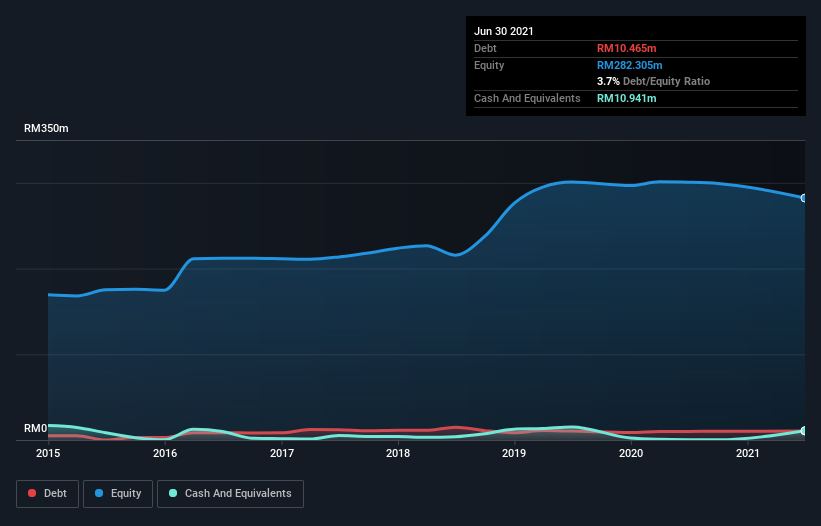Warren Buffett famously said, 'Volatility is far from synonymous with risk.' It's only natural to consider a company's balance sheet when you examine how risky it is, since debt is often involved when a business collapses. As with many other companies Tiger Synergy Berhad (KLSE:TIGER) makes use of debt. But should shareholders be worried about its use of debt?
When Is Debt Dangerous?
Debt assists a business until the business has trouble paying it off, either with new capital or with free cash flow. Ultimately, if the company can't fulfill its legal obligations to repay debt, shareholders could walk away with nothing. However, a more usual (but still expensive) situation is where a company must dilute shareholders at a cheap share price simply to get debt under control. By replacing dilution, though, debt can be an extremely good tool for businesses that need capital to invest in growth at high rates of return. The first step when considering a company's debt levels is to consider its cash and debt together.
See our latest analysis for Tiger Synergy Berhad
How Much Debt Does Tiger Synergy Berhad Carry?
The image below, which you can click on for greater detail, shows that at June 2021 Tiger Synergy Berhad had debt of RM10.5m, up from RM9.95m in one year. But on the other hand it also has RM10.9m in cash, leading to a RM476.0k net cash position.

How Strong Is Tiger Synergy Berhad's Balance Sheet?
The latest balance sheet data shows that Tiger Synergy Berhad had liabilities of RM8.25m due within a year, and liabilities of RM9.96m falling due after that. On the other hand, it had cash of RM10.9m and RM46.9m worth of receivables due within a year. So it actually has RM39.6m more liquid assets than total liabilities.
This surplus strongly suggests that Tiger Synergy Berhad has a rock-solid balance sheet (and the debt is of no concern whatsoever). On this view, lenders should feel as safe as the beloved of a black-belt karate master. Simply put, the fact that Tiger Synergy Berhad has more cash than debt is arguably a good indication that it can manage its debt safely. When analysing debt levels, the balance sheet is the obvious place to start. But it is Tiger Synergy Berhad's earnings that will influence how the balance sheet holds up in the future. So when considering debt, it's definitely worth looking at the earnings trend. Click here for an interactive snapshot.
Over 12 months, Tiger Synergy Berhad reported revenue of RM8.4m, which is a gain of 346%, although it did not report any earnings before interest and tax. That's virtually the hole-in-one of revenue growth!
So How Risky Is Tiger Synergy Berhad?
We have no doubt that loss making companies are, in general, riskier than profitable ones. And the fact is that over the last twelve months Tiger Synergy Berhad lost money at the earnings before interest and tax (EBIT) line. And over the same period it saw negative free cash outflow of RM3.4m and booked a RM15m accounting loss. With only RM476.0k on the balance sheet, it would appear that its going to need to raise capital again soon. Importantly, Tiger Synergy Berhad's revenue growth is hot to trot. While unprofitable companies can be risky, they can also grow hard and fast in those pre-profit years. When analysing debt levels, the balance sheet is the obvious place to start. But ultimately, every company can contain risks that exist outside of the balance sheet. For instance, we've identified 3 warning signs for Tiger Synergy Berhad (1 makes us a bit uncomfortable) you should be aware of.
Of course, if you're the type of investor who prefers buying stocks without the burden of debt, then don't hesitate to discover our exclusive list of net cash growth stocks, today.
Valuation is complex, but we're here to simplify it.
Discover if TWL Holdings Berhad might be undervalued or overvalued with our detailed analysis, featuring fair value estimates, potential risks, dividends, insider trades, and its financial condition.
Access Free AnalysisThis article by Simply Wall St is general in nature. We provide commentary based on historical data and analyst forecasts only using an unbiased methodology and our articles are not intended to be financial advice. It does not constitute a recommendation to buy or sell any stock, and does not take account of your objectives, or your financial situation. We aim to bring you long-term focused analysis driven by fundamental data. Note that our analysis may not factor in the latest price-sensitive company announcements or qualitative material. Simply Wall St has no position in any stocks mentioned.
Have feedback on this article? Concerned about the content? Get in touch with us directly. Alternatively, email editorial-team (at) simplywallst.com.
About KLSE:TWL
TWL Holdings Berhad
An investment holding company, engages in the property development and construction businesses in Malaysia.
Proven track record with adequate balance sheet.
Market Insights
Community Narratives



